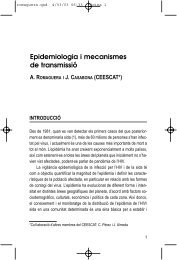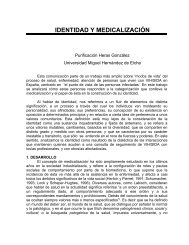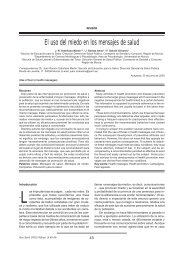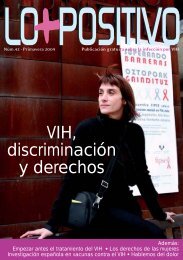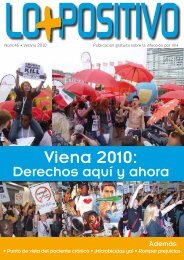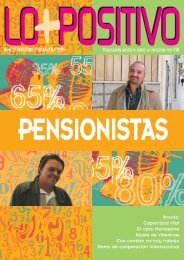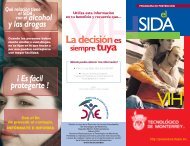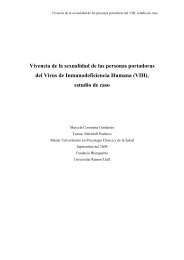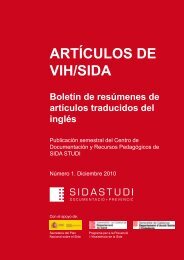HIV and injection drug use in Latin America - Sida Studi
HIV and injection drug use in Latin America - Sida Studi
HIV and injection drug use in Latin America - Sida Studi
Create successful ePaper yourself
Turn your PDF publications into a flip-book with our unique Google optimized e-Paper software.
<strong>HIV</strong> <strong>and</strong> <strong><strong>in</strong>jection</strong> <strong>drug</strong> <strong>use</strong> <strong>in</strong> Lat<strong>in</strong> <strong>America</strong> Rodríguez et al.S37MexicoIn 1983, AIDS ma<strong>in</strong>ly appeared among men who havesex with men (MSM), with some cases of MSM whowere also <strong><strong>in</strong>jection</strong> <strong>drug</strong> <strong>use</strong>rs. The first case of AIDS<strong>in</strong> an <strong><strong>in</strong>jection</strong> <strong>drug</strong> <strong>use</strong>r was recorded <strong>in</strong> 1986. Thenumber of IDU AIDS cases is <strong>in</strong>creas<strong>in</strong>g slowly [37].The first National Addictions Survey (NAS-88) [38]found that 0.1% of the population reported us<strong>in</strong>ghero<strong>in</strong>; of whom 17,000 claimed to have been active<strong>use</strong>rs <strong>in</strong> the previous year. By NAS-93, 30,000 <strong>in</strong>dividualsreported hav<strong>in</strong>g been active <strong>use</strong>rs <strong>in</strong> the previousyear. A regional comparison showed that the highestconsumption of illegal <strong>drug</strong>s took place <strong>in</strong> northwestMexico. The life prevalence hero<strong>in</strong> consumption <strong>in</strong>NAS-98 was 0.09%, which revealed no <strong>in</strong>crease <strong>in</strong> thepast 10 years, whereas for coca<strong>in</strong>e <strong>use</strong> it was 0.33% <strong>in</strong>1988 <strong>and</strong> <strong>in</strong>creased to 1.45% <strong>in</strong> 1998 [39].A study among prisoners [40] concluded that between90 <strong>and</strong> 95% of IDU cases <strong>in</strong> Mexico started <strong>in</strong> cities <strong>in</strong>which <strong>drug</strong> availability was significant, either beca<strong>use</strong> itwas produced there or there was local traffic. Bothsituations prevailed <strong>in</strong> northern Mexico.A study among groups of MSM, prisoners, sex workers<strong>and</strong> <strong><strong>in</strong>jection</strong> <strong>drug</strong> <strong>use</strong>rs <strong>in</strong> Baja California [41] foundthat <strong>HIV</strong> prevalence among homosexuals was 1.92%compared with 11.6% among bisexuals, 0.5% amongprisoners, <strong>and</strong> 2% among sex workers. Sent<strong>in</strong>el surveillanceshowed a 6% <strong>HIV</strong> prevalence among <strong><strong>in</strong>jection</strong><strong>drug</strong> <strong>use</strong>rs <strong>in</strong> 1998 [42]. Surveillance showed that40.9% shared syr<strong>in</strong>ges <strong>and</strong> only 35% cleaned them [43].ParaguayParaguay has very few epidemiological data about <strong>drug</strong><strong>use</strong>. Research organized <strong>in</strong> 1991 by Mar<strong>and</strong>ú, a nongovernmentalorganization (NGO), showed that alcohol<strong>and</strong> prescription <strong>drug</strong>s were more widely <strong>use</strong>d.IDU is responsible for 11% of all AIDS cases <strong>in</strong>Paraguay, with coca<strong>in</strong>e reported as the most frequently<strong>in</strong>jected <strong>drug</strong>. The male-to-female ratio of <strong>in</strong>fected<strong><strong>in</strong>jection</strong> <strong>drug</strong> <strong>use</strong>rs is 4.5 : 1 [44].UruguayCompar<strong>in</strong>g the National Prevalence Surveys <strong>in</strong> 1994<strong>and</strong> 1998, Uruguay shows a decrease <strong>in</strong> alcohol <strong>and</strong>tobacco <strong>use</strong>, an <strong>in</strong>crease <strong>in</strong> the <strong>use</strong> of tranquillizerswithout medical prescription, <strong>and</strong> stable rates of illegal<strong>drug</strong> <strong>use</strong>. In 1998, 19% of the <strong>drug</strong> <strong>use</strong>rs <strong>in</strong> rehabilitationhad <strong>in</strong>jected <strong>drug</strong>s dur<strong>in</strong>g their life, <strong>and</strong> 36% ofthem had shared syr<strong>in</strong>ges. Most of the <strong><strong>in</strong>jection</strong> <strong>drug</strong><strong>use</strong>rs reported <strong>in</strong>ject<strong>in</strong>g coca<strong>in</strong>e [45]. In Uruguay, IDUcontributes to 26% of all AIDS cases. Furthermore, <strong>in</strong> a1999 national study [46], 22.3% of reported <strong>HIV</strong>positivecases were <strong><strong>in</strong>jection</strong> <strong>drug</strong> <strong>use</strong>rs, with a maleto-femaleratio of 3.3 : 1.Policy <strong>and</strong> programmes: responses to theepidemicPolicies <strong>in</strong> Lat<strong>in</strong> <strong>America</strong> reflect a low tolerance of<strong>drug</strong> <strong>use</strong>rs. Authorities <strong>use</strong> legal sanctions to deal withthe problem, employ<strong>in</strong>g tactics of repression, primaryprevention, <strong>and</strong> obligatory abst<strong>in</strong>ence-based treatment.Most of the countries have specific <strong>drug</strong> acts <strong>and</strong>complementary legislation.Until recently, harm-reduction strategies were totallyhaphazard <strong>and</strong> unsystematic, <strong>and</strong> needle-exchange programmes(NEP) were uncommon [47]. Apart fromtheir attempt to encourage abst<strong>in</strong>ence, very few NGOswere <strong>in</strong>volved <strong>in</strong> prevention activities aimed at <strong><strong>in</strong>jection</strong><strong>drug</strong> <strong>use</strong>rs. Even now, harm-reduction activitiesare basically restricted to Brazil <strong>and</strong> Argent<strong>in</strong>a [2].In Brazil, <strong>in</strong>fection control policy related to the <strong>use</strong> ofpsychoactive substances is firmly backed up by theM<strong>in</strong>istry of Health [48]. In the Southern Cone,research <strong>and</strong> <strong>in</strong>terventions related to <strong>HIV</strong> <strong>in</strong> IDUbegan <strong>in</strong> 1997. In Buenos Aires, the NGO INTER-CAMBIOS developed a rapid assessment <strong>and</strong> responsestudy, <strong>and</strong> def<strong>in</strong>ed community <strong>in</strong>terventions that beganwith the first NEP <strong>in</strong> Argent<strong>in</strong>a [49]. In Uruguay, theNGO IDES developed a study to determ<strong>in</strong>e sex <strong>and</strong><strong>drug</strong> <strong>use</strong> knowledge, attitudes <strong>and</strong> practices (KAP) <strong>in</strong>Montevideo [50], <strong>and</strong> a study on <strong>HIV</strong>/AIDS riskpractices among commercial sex workers (CSW) [47].In Paraguay, the NGO PREVER contacted <strong><strong>in</strong>jection</strong><strong>drug</strong> <strong>use</strong>rs who reported <strong>in</strong>ject<strong>in</strong>g 1–10 times a day.Fifteen per cent were <strong>HIV</strong> positive <strong>and</strong> reportedengag<strong>in</strong>g <strong>in</strong> high-risk practices [51].In 2000, the regional project ‘<strong>HIV</strong> Prevention amongInject<strong>in</strong>g Drug Users <strong>in</strong> the Southern Cone’ beganwith the participation of NAP <strong>and</strong> NGO from eachcountry. Its objective is the adoption of legal <strong>in</strong>strumentsthat can facilitate prevention activities. It hopesto sensitize journalists <strong>and</strong> policy-makers, promoteaccess to healthcare networks for <strong><strong>in</strong>jection</strong> <strong>drug</strong> <strong>use</strong>rs,promote research <strong>and</strong> <strong>in</strong>tervention projects, <strong>and</strong> <strong>in</strong>volvecommunities <strong>in</strong> <strong>in</strong>terventions, particularly <strong>drug</strong><strong>use</strong>rs <strong>and</strong> their networks. Argent<strong>in</strong>a implementedpreventative <strong>in</strong>terventions that <strong>in</strong>cluded syr<strong>in</strong>ge <strong>and</strong>condom distribution. In addition, it developed aseroprevalence study for <strong>HIV</strong> <strong>and</strong> hepatitis B <strong>and</strong> C.Chile developed a rapid assessment <strong>and</strong> response study<strong>and</strong> educational activities for communities <strong>and</strong> <strong><strong>in</strong>jection</strong><strong>drug</strong> <strong>use</strong>rs. Paraguay worked to plan <strong>in</strong>terventions<strong>in</strong> prisons. Uruguay began an ethnographicstudy of IDU, <strong>and</strong> surveyed the healthcare servicesavailable to <strong>drug</strong> <strong>use</strong>rs <strong>and</strong> <strong>HIV</strong>-positive <strong>in</strong>dividuals.All projects tra<strong>in</strong>ed healthcare professionals [52]. In2002, the United Nations Office for Drug Control<strong>and</strong> Crime Prevention (UNDCP) <strong>and</strong> UNAIDS are



